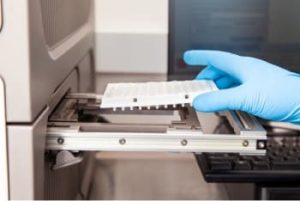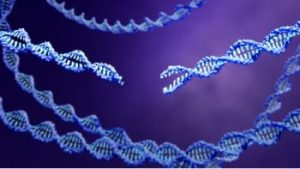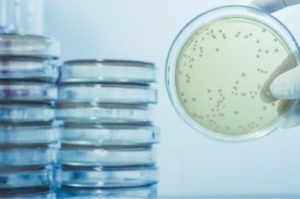Attachment Chemistry / Linkers Modifications
Amino Modifiers
A primary amino group can be used to attach a variety of modifiers (such as fluorescent dyes) to an oligonucleotide or used to attach an oligonucleotide to a solid surface. Amino modifiers can be positioned at the 5’-end with either a standard (C6) or longer (C12) spacer arm. Amino modifications can be positioned at the 3’-end. Internal amino modifications can be introduced using an amino-dT base.
Amino Modifier C6
View product details for Amino Modifier C6:
Amino Modifier C12
View product details for Amino Modifier C12:
Amino Modifier C6 dT
View product details for Amino Modifier C6 dT:
Amino Modifier
View product details for Amino Modifier:
Uni-Link™ Amino Modifier
Uni-Link™ is an amino-modifier phosphoramidite from Clontech that provides a free primary amine attached to the 5'-end of an oligo via a six carbon aliphatic spacer arm. It is functionally interchangeable with Amino Modifier C6.
View product details for Uni-Link™ Amino Modifier:
Biotinylation
Biotin-modified oligos bind tightly to streptavidin. The streptavidin can be labeled with fluorescent dyes and enzymes or mediate attachment to a solid surface. A variety of molecular biology assays and purification methods employ biotin. Biotin can be added to the 5’- or 3’-ends of an oligo using either a C6 (standard) or TEG (tetra-ethyleneglycol, 15 atom) spacer arm. 5' Biotin-TEG requires purification. Internal biotin modification can be introduced using a biotin dT base, which also requires additional purification.
Biotin
View product details for Biotin:
Biotin (Azide)
Biotin (Azide) is attached to the oligo sequence through a 1,2,3-triazole linkage. The 1,2,3-triazole linkage is formed from the reaction of azides and alkynes in the presence of copper (I), in the click reaction. The internal version of this modification is attached to the oligo through a dT base. Incorporation of the internal version will add a dT nucleotide at that position. To avoid adding an extra nucleotide, replace an existing T nucleotide in your sequence with the required modification.
View product details for Biotin (Azide):
Biotin dT
View product details for Biotin dT:
Biotin-TEG
Biotin-TEG has an extended spacer arm.
View product details for Biotin-TEG:
Dual Biotin
Two biotin groups are sequentially placed on the 5’-end, which increases the efficiency of streptavidin binding.
View product details for Dual Biotin:
PC Biotin
PC Biotin produces a photocleavable spacer between the biotin group and the DNA bases. Optimal cleavage is obtained with exposure to long-wave UV light in the 300-350 nm spectral range. Cleavage releases the oligo with a 5'-phosphate group.
View product details for PC Biotin:
Desthiobiotin-TEG
Desthiobiotin is a biotin analog that is missing the sulfur atom. Its affinity to streptavidin is lower than that of biotin. Displacement of desthiobiotin to streptavidin can occur by simply adding biotin to a reaction mixture.
View product details for Desthiobiotin-TEG:
Thiol Modifications
A thiol group can be used to attach an oligo to a variety of fluorescent and nonfluorescent moieties or surfaces. Oligos containing thiol modifiers are shipped in their oxidized (disulfide) form and require chemical reduction by dithiothreitol (DTT) or Tris (2-carboxyethyl) phosphine (TCEP) prior to use. View reduction protocol for thiol-modified-oligonucleotides.
Thiol Modifier C3 S-S
View product details for Thiol Modifier C3 S-S:
Dithiol
View product details for Dithiol:
Thiol Modifier C6 S-S
The internal Thiol Modifier can be placed within a molecule, which will then fragment the flanking regions at the disulfide bond. This can be used for intentional breakage of the oligo into two fragments, or liberation of a fluorophore or other modification via disulfide reduction. This will result in two reactive sulfhydryl groups.
View product details for Thiol Modifier C6 S-S:
Alkynes
Alkyne modifiers are used to react with azide labeled functional groups to form stable bonds through the azide alkyne Huisgen cycloaddition reaction. This reaction is commonly referred to as the click reaction.
5' Hexynyl
This modification is the simplest way to introduce a 5' terminal alkyne group. Alkynes readily react with azides in the presence of copper (I) to form stable 1,2,3-triazole bonds. This is the most popular form of the click reactions.
View product details for 5' Hexynyl:
5-Octadiynyl dU
5-Octadiynyl dU is a modified base with an eight carbon linker terminating in an alkyne group. Use of this modified base is the preferred way to insert alkynes at internal positions within a sequence.
View product details for 5-Octadiynyl dU:
Additional
DBCO
Used for copper-free click reactions
View product details for DBCO:
Acrydite™
Acrydite™ is an attachment chemistry based on an acrylic phosphoramidite that can be added to oligonucleotides as a 5’-modification. Acrydite-modified oligonucleotides covalently react with thiol-modified surfaces or can be incorporated into polyacrylamide gels during polymerization.
View product details for Acrydite™:
Adenylation
T4 RNA Ligase uses ATP to adenylate the 5'-end of a single-strand nucleic acid sequence. This activated adenylated-oligo is then covalently connected (ligated) to the 3'-OH of a second single-stranded sequence. Adenylated oligonucleotides containing a pyrophosphate linkage are substrates for T4 RNA Ligase in the absence of ATP (1). IDT will custom adenylate an oligonucleotide for use with RNA-Ligase using the chemical adenylation method of Unrau and Bartel (2). T4 RNA Ligase will use an adenylated DNA linker with similar efficiency as an adenylated RNA linker and IDT recommends use of adenylated DNA oligos for this application. Note that IDT requires blocking the 3'-end of an adenylated oligo so it cannot circularize; use of either 3'-Spacer C3 /3SpC3/ or dideoxycytosine /3ddC/ is preferred. References 1. England, T.E., Gumport, R.I. and Uhlenbeck, O.C. (1977) Dinucleoside pyrophosphate are substrates for T4-induced RNA ligase. Proc Natl Acad Sci U S A, 74, 4839-4842. 2. Unrau, P.J. and Bartel, D.P. (1998) RNA-catalysed nucleotide synthesis. Nature, 395, 260-263.
View product details for Adenylation:
Azide (NHS Ester)
IDT's Azide modification uses an NHS Ester functional group to attach an azide moiety at the 5', 3' or any internal position in an oligo. This azide moiety may subsequently be used to attach alkyne modified groups through the click reaction. The internal version of this modification is attached to the oligo through a dT base. Incorporation of the internal version will add a dT nucleotide at that position. To avoid adding an extra nucleotide, replace an existing T nucleotide in your sequence with the required modification.
View product details for Azide (NHS Ester):
Cholesterol-TEG
Cholesterol can be conjugated to oligonucleotides and can facilitate uptake into cells. It has been used as a transfection aid for antisense oligos and siRNAs, both in vitro and in vivo. Cholesterol is a very hydrophobic modification that is best purified using RP-HPLC.
View product details for Cholesterol-TEG:
Digoxigenin (NHS Ester)
Digoxigenin is a small hapten that can be conjugated to amino-modified oligos. Anti-digoxigenin antibodies allow capture or detection of a digoxigenin-labeled oligo and can be used in a variety of assay formats much like biotin/streptavidin.
View product details for Digoxigenin (NHS Ester):
I-Linker
I-LinkerTM, developed at IDT, is a proprietary covalent attachment chemistry for oligonucleotides. The modifier is attached to the 5'-end of the oligo. I-LinkerTM can be substituted for amino modifications in many applications. In addition, I-LinkerTM expands the range of reactive groups that can be used for conjugation, including aldehyde and ketone-modified ligands or surfaces.
View product details for I-Linker:





















